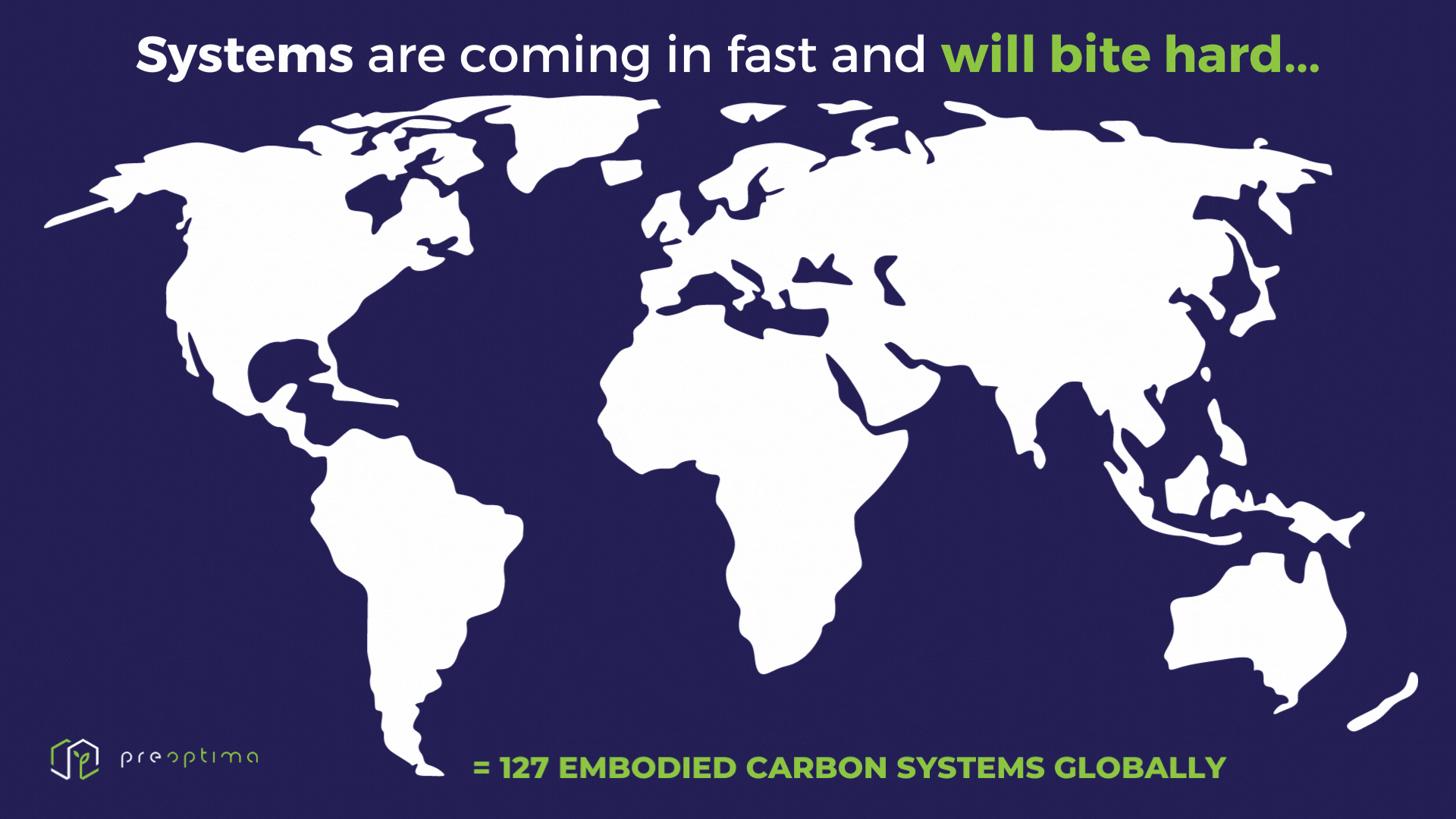Covering Embodied Carbon Series
Global Embodied Carbon Regulations
Read Time 9 mins | Written by: Alex Bantock
The construction industry has long prioritised the use stage of a building, whether due to dirty grids increasing the significance of operational emissions, the industry's focus on energy efficiency, the ease of operational emissions quantification, or the vastly different durations of the upfront and use stages, embodied carbon has somewhat been in it's operational counterpart's shadow. However, embodied carbon is finally being pulled from the shadows and into the spotlight — and it’s high time we took notice.
With a significant portion of the embodied carbon emissions from previously constructed buildings effectively 'locked' in, the focus has understandably shifted towards the environmental footprint of new builds. With a steady stream of research and reports showing our precarious position on the brink of environmental disaster — quite literally walking on thin ice — the time for blissful ignorance is officially over. By some estimates, embodied carbon from new construction required to keep pace with population growth could consume nearly a quarter of our 400 Gt CO2e carbon budget until 2050.
"The global urban population is set to grow by 2.75 billion by 2060. The required new buildings will create over 100 gigatons of embodied carbon – more than three years’ global fuel combustion carbon emissions. If carbon intensity is not drastically cut, global construction activity carbon until 2060 may exceed 230 gigatons."
In confronting this emerging challenge, the industry can't solely rely on the goodwill of individuals and organisations. It will take a coordinated effort involving a range of policies, mandatory regulations, voluntary standards, certifications, and guidelines — collectively referred to here as 'systems' — to steer the industry towards lower embodied carbon footprints. These systems not only serve to prompt the industry to recognise, measure, and reduce embodied carbon, but they also provide the necessary frameworks to guide and enforce sustainable practices.
Embodied Carbon Regulations
There has been a noticeable uptick in the global adoption of these systems, signalling an encouraging shift towards embodied carbon reduction. Nevertheless, these systems are not evenly distributed worldwide, and keeping pace with this dynamic regulatory landscape can prove challenging, especially considering the diverse range of administrative actors involved, from national and state governments to professional organisations and industry groups.

Skip to examples of global embodied carbon systems
What is out there?
Some regions have led the charge in implementing embodied carbon systems, with other carbon-intensive regions decidedly lagging considerably. Europe, for instance, has been at the forefront, with France, Switzerland and the Nordic countries implementing mandatory requirements for embodied carbon calculations for certain types of buildings along with a host of certifications. The United Kingdom (UK) is also experiencing a strong organisational push, with the UK Government somewhat following.
Other high emitters, such as North America, are showing strong state- and city-level action but appear to be more focused on procurement, which relates to the late design and construction stages of the building lifecycle. Therefore, systems (in particular mandatory regulations) targeting upfront embodied carbon are urgently needed.
Meanwhile, the Asia-Pacific region, where a significant portion of the world's construction is happening, is playing catch-up. Countries like China and India have rolled out Green Building Standards and Codes that include embodied carbon considerations. Although Australia and New Zealand have some ground to cover, their systems are expected to improve significantly in the near future.
How embodied carbon is addressed
Embodied carbon features as either a mandatory or optional requirement within each system, with a specific method with which to address it. Typically, one of the following five methods of addressing embodied carbon is used in systems:
.png?width=680&height=383&name=EC%20Regulations%20(2).png)
The methods range in efficacy based on their ability to reduce carbon, from building general knowledge and awareness with limited reduction (carbon reporting) to incentivising reduction as much as possible through direct cost from higher carbon emissions (decarbonisation). Each of the different methods is thus accompanied by unique advantages as well as difficulties, which are usually determined by the type of system used and the context in which it is used. Whilst the strongest methods (quantified decarbonisation targets aligned with a Net Zero scenario) within the strongest systems (mandatory regulations) are preferred, some consideration of embodied carbon is arguably better than none.
Looking ahead
As we look ahead, we can expect a significant rise in embodied carbon systems as part of global efforts to mitigate climate change. By 2030, embodied carbon is expected to account for more than 50% of total new construction emissions with no sector interventions. Hence, it is imperative for systems to address this massive impact at scale, and with Net Zero targets sprouting from countries and cities worldwide, it is expected that global systems will have to step up to the challenge one way or another.
Given the expected trajectory of these systems, it's essential that the industry equips itself with the necessary tools to measure, mitigate, and manage embodied carbon emissions effectively. There are numerous tools available today for measuring and mitigating embodied carbon. Life Cycle Assessment (LCA) or Whole Life Carbon (WLC) software solutions, combined with the rise of digital technologies and robust carbon databases, are increasingly enhancing the accuracy and efficiency of embodied carbon calculations.
Being ready with these tools will not only ensure regulatory compliance but also position firms to be leaders in the transition towards a more sustainable built environment. As we navigate the path towards our climate goals, the increase in embodied carbon regulations worldwide is a promising sign of our collective commitment to a sustainable future. With the right tools and guidance, we can steer our built environment towards a more sustainable trajectory.
The journey ahead is undeniably challenging, however, the shift in focus towards embodied carbon is not just promising but pivotal in setting us firmly on the path towards a built environment that is in harmony with our climate goals. We should encourage the introduction of new systems within our own regions and be prepared with the right tools to ensure that we embrace them fully. By harnessing these solutions, industry leaders can not only ensure compliance with ever-evolving regulations but also spearhead the shift towards a sustainable built environment.
Global
- BREEAM International - BRE Group (certification, embodied carbon optional)
- Living Building Challenge - International Living Future Institute (certification, embodied carbon required)
- The Net Zero Carbon Buildings Commitment - World Green Building Council (commitment, embodied carbon required)
- EDGE Buildings - International Finance Corporation (IFC) (certification, embodied carbon optional)
Europe & United Kingdom
Europe:
- Environmental Regulation 2020 (RE2020) - France (regulation, embodied carbon required)
- The Climate Declaration Act for New Buildings - Sweden (regulation, embodied carbon required)
- Bepalingsmethode Milieuprestatie - Netherlands (standard, embodied carbon required)
- FutureBuilt - Norway (certification, embodied carbon required)
United Kingdom:
- Whole life carbon assessment for the built environment - Royal Institution of Chartered Surveyors (RICS) (standard, embodied carbon required)
- The London Plan - Greater London Authority (GLA) (regulation, embodied carbon optional)
- BREEAM UK - BRE Group (certification, embodied carbon optional)
North America
- Zero Carbon Building Standard - Canada Green Building Council (CAGBC) (certification, embodied carbon required)
- Leadership in Energy and Environmental Design (LEED) - US Green Building Council (USGBC) (certification, embodied carbon optional)
- Local Law 97 - New York, USA (regulation, embodied carbon optional)
- SE2050 - Structural Engineering Institute, USA (pledge, embodied carbon required)
Asia-Pacific
- Green Star Australia - Green Building Council Australia (GBCA) (certification, embodied carbon optional)
- State Environmental Planning Policy (Sustainable Buildings) 2022 - New South Whales, Australia (regulation, embodied carbon required)
- Whole-of-Life Embodied Carbon Emissions Reduction Framework - New Zealand (policy, embodied carbon required)
- Green Star NZ - New Zealand Green Building Council (NZGBC) (certification, embodied carbon optional)
Asia:
- China Green Building Label (Three Star) - China (certification, embodied carbon optional)
- G-SEED - Korea (certification, embodied carbon optional)
- BCA Green Mark - Singapore (certification, embodied carbon optional)
We'd love to hear from you!

